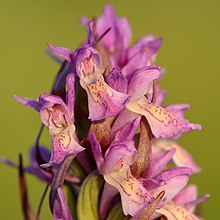Flesh-colored orchid
| Flesh-colored orchid | ||||||||||||
|---|---|---|---|---|---|---|---|---|---|---|---|---|

Flesh-colored orchid ( Dactylorhiza incarnata ) |
||||||||||||
| Systematics | ||||||||||||
|
||||||||||||
| Scientific name | ||||||||||||
| Dactylorhiza incarnata | ||||||||||||
| ( L. ) Soó |
Dactylorhiza incarnata ( Dactylorhiza incarnata ), more rarely Steifblättriges orchid called, belongs to the genus orchids ( Dactylorhiza ) of the family of orchids (Orchidaceae). The species was voted Orchid of the Year 2015 in Germany.
description
The flesh-colored orchid is a perennial herbaceous plant that reaches heights of 20 to 60 cm. The geophyte forms, as is typical for the genus, hand-shaped divided tubers as persistence organs. Characteristic of the flesh-colored orchid is the strong, hollow stem, which is easily compressible and angular in the upper part. The four to seven leaves are stiffly upright, more rarely bent back, narrowly lanceolate, light green, up to 20 cm long, up to 3 cm wide and unspotted. The lowest leaves are the widest. The inflorescence is 5 to 12 cm long. The bracts are longer than the flowers. The zygomorphic flowers are flesh-colored, occasionally light pink. The lateral sepals (sepals) are erect, a little less than 10 mm long, about 3 mm wide. The petals incline to form a helmet. The lip has a loop pattern, more rarely a point pattern, and is 5 to 8 mm long, about as wide, usually with entire margins. The flowers do not produce nectar ( nectar deception flower ). The spur is up to 10 mm long and conical. The Central European flowering time of the flesh-colored orchid begins at the beginning to mid-May and ends in mid-June.
The number of chromosomes is 2n = 40.
Distribution and occurrence
The distribution area of the flesh-colored orchid extends from Europe to northwestern China.
In Germany mainly in Bavaria , Baden-Württemberg , Brandenburg and Mecklenburg-Western Pomerania , rarely in the other federal states. The species is considered endangered in Germany ( Red List of Endangered Species in Germany, Category 2 ). In Switzerland still common, only in areas with intensive use rare or absent.
Locations and distribution in Central Europe
The flesh-colored orchid needs base-rich, but not necessarily lime-rich, loamy soil that should be damp or wet at least at times.
It inhabits swamp meadows, flat moors and wet and light forests. It occurs in wet meadows and low and intermediate moors and prefers basic soils. In the Alps it rises up to 1500 m. In the Allgäu Alps, it rises up to 1,320 meters above sea level. It is generally rare in Central Europe, but sometimes occurs in smaller, loose stands with few individuals in its growing areas. It occurs in Central Europe especially in societies of the associations Caricion davallianae or Calthion.
According to Baumann and Künkele , the species has the following altitude limits in the Alpine countries: Germany 2-1320 meters, France 0-2200 meters, Switzerland 350-2050 meters, Liechtenstein 430-580 meters, Austria 120-1800 meters, Italy 12-2100 meters, Slovenia 50-1490 meters.
Systematics
Subspecies
One can distinguish the following eight subspecies:
- Dactylorhiza incarnata subsp. coccinea (Pugsley) Soó : It occurs in Great Britain and Ireland.
- Blood Red Orchid ( Dactylorhiza incarnata subsp. Cruenta (OFMüll) PDSell. ): It happens from Europe to num northwestern China.
- Dactylorhiza incarnata subsp. gemmana (Pugsley) PDSell : It occurs in Western Europe.
- Dactylorhiza incarnata (L.) Soó subsp. incarnata : It occurs from Europe to Central Asia .
- Dactylorhiza incarnata subsp. jugicrucis Akhalk., R. Lorenz & Mosul. : It occurs in Transcaucasia .
- Dactylorhiza incarnata subsp. lobelii (Verm.) HAPedersen : It occurs in Norway , Denmark and the Netherlands .
- Straw-yellow orchid ( Dactylorhiza incarnata subsp. Ochroleuca (Wüstnei ex Boll) PFHunt & Summerh. ): It occurs in Europe.
- Dactylorhiza incarnata subsp. pulchella (Druce) Soó : It occurs in Europe.
Hybrids
Hybrids with the broad-leaved orchid ( Dactylorhiza majalis ) are very common . Further hybrids are formed with the elder orchid ( Dactylorhiza sambucina ), Traunsteiner's orchid ( Dactylorhiza traunsteineri ) and the spotted orchid ( Dactylorhiza maculata ). These are usually difficult to determine.
ecology
This species is more demanding than the broad-leaved orchid ( Dactylorhiza majalis ). If the biotope changes , it disappears faster.
literature
- Dietmar Aichele, Heinz-Werner Schwegler: The flowering plants of Central Europe . Franckh-Kosmos-Verlag, 2nd revised edition 1994, 2000, Volume 5, ISBN 3-440-08048-X
Web links
- Dactylorhiza incarnata. In: FloraWeb.de.
- Flesh-colored orchid . In: BiolFlor, the database of biological-ecological characteristics of the flora of Germany.
- Profile and distribution map for Bavaria . In: Botanical Information Hub of Bavaria .
- Dactylorhiza incarnata (L.) Soó s. l. In: Info Flora , the national data and information center for Swiss flora . Retrieved October 1, 2015.
- Distribution in the northern hemisphere according to: Eric Hultén , Magnus Fries: Atlas of North European vascular plants 1986, ISBN 3-87429-263-0
- Thomas Meyer: Data sheet with identification key and photos at Flora-de: Flora von Deutschland (old name of the website: Flowers in Swabia )
- The orchids of the Rhön: Dactylorhiza incarnata , flesh-colored orchid
Individual evidence
- ↑ Plant portrait of flesh-colored orchid, orchid of the year 2015, by Bernd Margenburg, Bochumer Botanischer Verein
- ↑ a b Erich Oberdorfer : Plant-sociological excursion flora for Germany and neighboring areas . 8th edition. Verlag Eugen Ulmer, Stuttgart 2001, ISBN 3-8001-3131-5 . Page 282.
- ↑ a b c d e f g h i j Rafaël Govaerts (Ed.): Dactylorhiza incarnata. In: World Checklist of Selected Plant Families (WCSP) - The Board of Trustees of the Royal Botanic Gardens, Kew . Retrieved November 29, 2016.
- ↑ Erhard Dörr, Wolfgang Lippert : Flora of the Allgäu and its surroundings. Volume 1, IHW, Eching 2001, ISBN 3-930167-50-6 , p. 372.
- ↑ Helmut Baumann , Siegfried Künkele : Orchidaceae . In: Oskar Sebald u. a .: The fern and flowering plants of Baden-Württemberg. 1st edition Volume 8, page 362. Verlag Eugen Ulmer, Stuttgart 1998. ISBN 3-8001-3359-8




